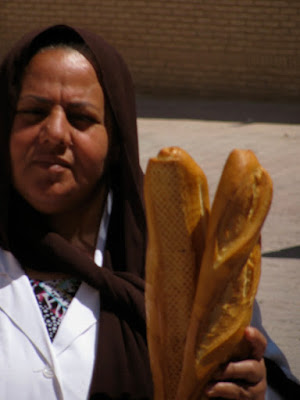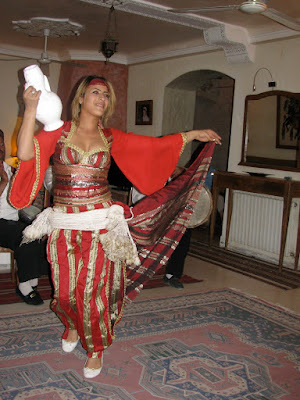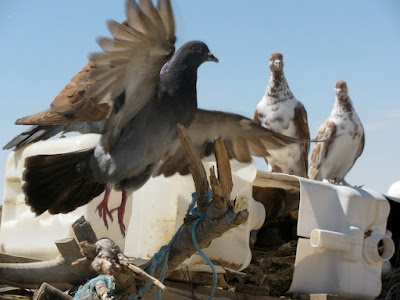DAY 9, TUESDAY, MAY 10th Brick factory Visit the Eden Palm Museum Optional Arabian Soirée
Breakfast this morning was at 6:30 am. I walked around the hotel (below) and at 8:30 pm left the hotel to visit the brick factory outside of town.
We visited a primitive operation conducted by a self employed man working out in the middle of a desolate area. He used an ancient method for making bricks that was really quite simple and cost effective. First of all he started with a mixture of clay that was easily accessible. Then he poured the contents of his pail into a mixture of water and mixed it with his hands. The subsequent glob of clay was spread into wooden forms. The wet bricks were set out to dry. Later when he had a sufficient number of bricks to fire, he placedthe bricks into a kiln. The finished product was stacked ready to be distributed to customers.
For our next activity we headed back into Tozeur to visit a traditional dress business where some of our group could try on outfits
Snacks and warm sweet tea were served
Followed by hand-clapping African music.
Narrow passageways contributed to the closeness of the community
Residents still purchased freshly baked bread from the market and carried them in their arms.
At the end of our Old Town walk, Mohamed gave us free time to roam the market place
Which happened to be a security zone because it was connected with government. Note the soldiers and the strung out barb wire.
Our lunch break took us to a fancy golf course and swanky resort. A sculpture of a Tunisian poet was placed on a rocky outcrop.
Lunch offered lamb chops which were better than usual.
Linda preferred fish and our ever helpful guide removed the bones for her.
After lunch we loaded up into horse drawn carriages that drove around the palm tree areas. The ride was rather bumpy. Not quite like Central Park in NYC.
Since this was palm tree country, we took in a tour of the Eden Palm Museum which focuses on the role of the date palm in Tunisian society. For two thousand years, this city has thrived in a lush oasis on the edge of the largest salt flat in Northern Africa, and was a remote and fiercely independent enclave for much of that time. Its prosperity peaked during the age of the great trans-Saharan camel caravans between the 14th and 19th centuries. When Scottish traveler Dr. Thomas Shaw arrived in 1757, he noticed the great traffic in slaves brought from as far away as the River Niger; the exchange rate was one slave for 200 kg of dates.
We felt the true oasis atmosphere here as we explored byways where spring-fed canals (some 200 springs and artesian wells) water vegetation. The oasis of Tozeur, an intensively cultivated area of some 2,600 acres, lies immediately south of the town. It contains some 400,000 date-palms, which provide shade for fruit trees (peaches, apricots, pomegranates, figs, citrus fruits and bananas). Ground crops such as vegetables, salad plants and corn, which consume a great deal of water, are only occasionally found. The palms yield between 25,000 and 30,000 tons of dates annually, including only 1000 tons of the top quality deglat en nour dates - particularly aromatic, semi-sweet and not too soft - which grow only at the tips of palms in good soils well supplied with water.
Our tour of the Eden Palm Museum ended in a tasteful manner. Samples of date products were set out so they could be spread on pieces of bread. Those who so wished, could purchase products from the cashier.
This evening we joined an optional excursion for an Arabian Soiree. Mohamed said that a wealthy man established this estate which he gradually expanded for use by his invited guests. We traveled to this peaceful farmhouse situated on a plantation of date palms for an evening of authentic Tunisian entertainment, and dined on home-cooked local specialties. After a tour of the unique complex we headed for the kitchen where we were introduced to the cook.
She offered hands on experience for those willing to make their very own serving for the dinner tonight.
Several volunteered.
Before dinner we were offered our choice between white or red wine.
We were led to a nice lounge area facing musical performers. The first performer played nice soft music on a lute.
The second group played what was called “traditional music.” It was rather loud, but I could just turn off my hearing aid making it just right. Some covered their ears. The music was lively and seemed especially geared for belly dancing.
The meal was served buffet style and I thought it was the best food so far on the trip.
Then the Arabian dance performances by a rather energetic young lady.
Her second series of dances included audience participation.
Apparently, she saved the more exotic numbers for last
Lodging Ras El Ain Hotel Tozeur
DAY10, WEDNESDAY May 11th
At leisure in Tozeur
or Optional Mountain Oases tour
This morning I took pictures of flowers before breakfast since they were along the walkway,
I had signed up for an optional full-day Mountain Oases tour to the oasis towns of Chébika,
Tameghza, and Mides—set in stunning mountain gorges and boasting histories going back to ancient Roman times.
We boarded four-wheel-drive vehicles and headed first for Chébika RG p.353; LP p. 229, a village of stone and clay houses set on a terrace overlooking an oasis, a river gorge, and a deep ravine.
Stone and clay house
The mountain we were to climb at Chebika. Note the crevice we were to squeeze though.
Coming out the other side
Looking ahead to the descent
Source of a mountain spring spring - with warm water
Taking in the shade
Flowing water
Yep, warm water from the waterfall
Wet sweatband on Fred’s hat after the “walk”
Back on the road again
Beautiful terrain
Desert Rose
Border Security Guards near Algerian Border (Tameghza)
Street in Tameghza
Scenery on way to Mides
Ruins of Mides
View of Algerian border from Mides
Canyon view at Mides
Famous house in Mides used in the movie English Patient
Fortress at Mides
Goats
Prickly Pear Cactus
Canyon Mides
Back to Tameghza for lunch
View the Roman and Byzantine history of Tameghza RG p. 351; LP p. 229, photo p. 200
through the restaurant window.
Bedouin Desert Life discussion
We drove to a Bedouin encampment that seemed to be very primitive. We exited our vehicles and walked around.
The young boy of the family watched us as we explored. His father was watering a horse.
Animals were kept in an enclosure.
We continued on into the desert.
When we reached high sand dunes we were told to hang on. Our lead car went first and then I
snapped the other cars as they came over.
Here at Ong Jemal these sand dunes were used by the crew of the English Patient who indulged in lots of billowing sand-blown romantic stuff. LP p. 230
We viewed the Star War sets below that are still in place. Created just for the movies.
On the way back to our hotel we came across a number of camels sitting on the roadway.
Lodging:Ras El Ain Hotel
DAY 11, THURSDAY May 12th
Salt Flats
Discover Bedouin wedding traditions
Travel to Sahara Desert Camp
We departed Tozeur this morning Luggage out at 7:30 am and departure 8:00 am. Our journey started at the upper left on the map above; we took the causeway across the salt flats to Souk Lahad and Kebili to Douz. From here we cross the desert to the Camp (marked C).
The salt flats
Water cooler at Souk Lahad
Very hot water splashes downward exposed to air in the water cooler device
For further cooling the water is channel through lengthy canals
Yep, it is still warm
And then the relatively cooler water is carried off on this final canal
DAY 11, THURSDAY May 12th
Tour Douz
Camel rides
Discover Bedouin wedding traditions
Travel to Sahara Desert Camp
At Douz we approached this city gate where our bus dropped us off for exploring. RG Map 379; info pp. 377-383; LP p. 215-220; IG Map. p. 279,
I used most of my time people watching.
Members were given the opportunity to ride camels into the Sahara.
I had done that before so used my time watching a sky glider perform
We joined a Bedouin family in their home for a discussion on wedding garments and customs. Many Bedouins had once lived out in the desert until the wells started drying up in the late 1980s so they are now in the city. Clans hope to move back.
The happy bride and groom
In a traditional wedding the bride has her hands painted with henna in an elaborate design
And finally it was time to load up in our four wheel drives and head into the Sahara for the tented camp.
We were greeted with warm tea.
I checked into my tent with bedding adequate for a cool night.
A member of the camp staff gave a bread baking demonstration without using an oven
He placed the bread dough on the hot sand and then covered it with hot embers. We could see the dough bubble like pancakes. When it was done he brushed off the sand and distributed pieces of bread among us. Not bad!
Mohamed took us out of the camp to a high sand dune where we drank white and red wine while watching roaming camels under a starry sky
and waited for the sunset on the Grand Erg
That evening after dinner we had live entertainment
DAY 12, FRIDAY, May 13th
In the morning all appeared calm so our group must have sleep well.
After breakfast the drivers were ready to take us across the open dessert --without roads.
At times it was hairy and one time our drivers stopped for consultation.
Which gave us time to look over the Sahara Desert. The break helped recover from
being tumbled like a rag doll in a dryer.
We came upon a Roman fortress -- probably it was the least popular place to serve in the Roman guards, so isolated and hot. Here we explored the ancient Roman fort of Tisavar.
It had probably gone through just a few alterations in its history, mainly being rebuilt to serve the purposes of Berber tribes in the 16th century. Its condition was of course poor; it wasn't built to survive the centuries.
Finally we reached Ksar Ghilhane which had formerly been considered as a site for OAT tent camping. RG pp. 380,475-476, LP p. 222
We ate lunch here -- the best part was the salad. I’m not one for French fries
We traveled on roads now which were shared with goats. but they were ROADS.
The bus was really comfortable after our trek in the desert with 4x4s.
GO ON TO 2011 TUNISIA Part IV: Matmata, Tatouine, Ksar Routes & Jerba






















































































































































































No comments:
Post a Comment